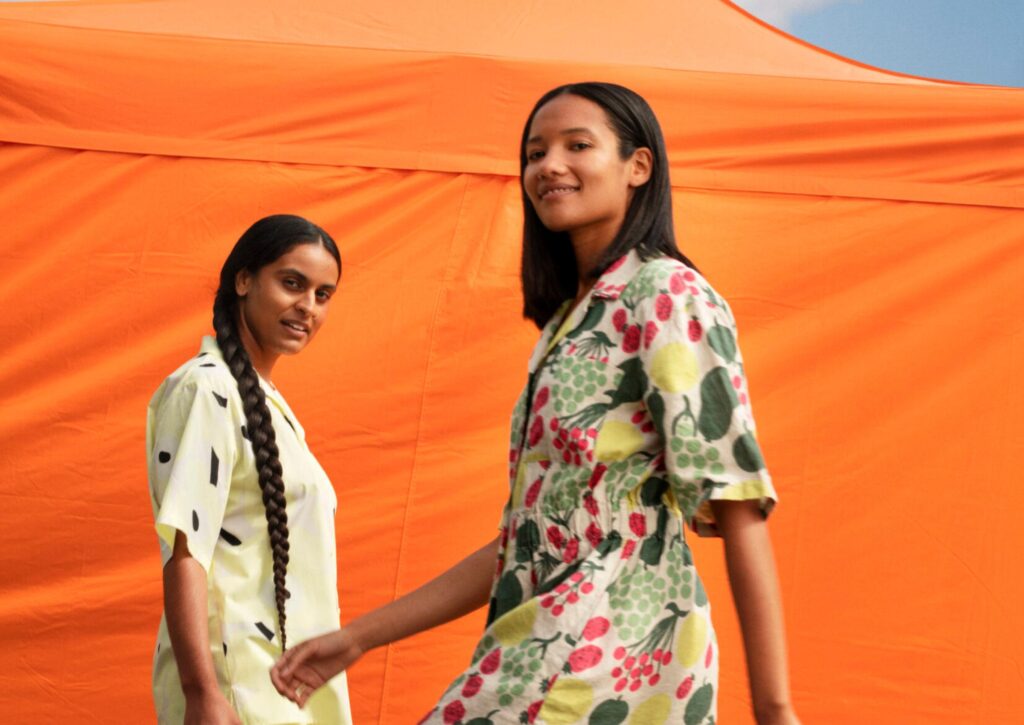Fashion Revolution Week is the time when we come together as a global community to create a clean, safe, fair, and accountable fashion industry. Founded in the wake of the Rana Plaza disaster in 2013, the movement aims to shed light on the global fashion supply chain and the people behind the clothes we wear. As sustainability has always been part of Marimekko’s DNA, we want to provide our customers with timeless, functional, and durable products as transparently as possible. This is how we do it.
The journey of a dress
The supply chains of clothing and accessories all the way from raw materials to a finished product are very long and challenging to track. The environmental impact is caused by the growing of the raw materials, processing of the fibers, manufacturing of yarn, dyeing, sewing, logistics, storage, washing and maintenance – and ultimately waste and recycling. As the fashion industry is responsible for a significant amount of greenhouse emissions every year, we all have a responsibility to do our best to contribute to a more sustainable future.
To achieve the ambitious goals set out in our sustainability strategy, we always assess the entire life cycle of our product. It is the only way to truly prolong the life of a product and, on the other hand, minimize the negative effects during production. We are committed to seek and find the best and most responsible practices, materials and craftsmanship for each product out there by building long-term relationships with our suppliers. Lithuanian manufacturer Edmundas is a great example of our long-standing partners and has been a supplier of ours since 2010. The skilled team at the supplier and their factories gives countless Marimekko dresses their final form every year. But let’s rewind a bit and investigate what sorts of actions we take before a dress becomes a dress.
Chapter 1: Timeless design
According to a study by the Ellen MacArthur Foundation, specialized in circular economy, using products twice as long would reduce emissions of the fashion industry by up to 44%. Therefore, a long-life cycle contributes significantly to the sustainability of a product. That is why Marimekko designers don’t do fast fashion. We focus on timeless design that leaves as little burden as possible for the coming generations.
But how to create a sustainable summer dress? The Herkku Pieni Tori linen dress serves as an epitome of timeless design. First, it is a shirt dress, a true fashion classic and one of the iconic archetypes in Marimekko’s 70-year-old dress archives. You can dress this classic up or down depending on the occasion that you’re wearing it for. In addition, unbleached linen is an easy and breathable choice of material that repels dirt and – hear us out – also looks great wrinkled.
However, there is even more timelessness in this dress. A camp shirt, a cabin shirt, a cabana shirt, or a lounge shirt – beloved classics are often given many names. The Herkku linen dress has got its collar inspiration from this 1950s men’s fashion favorite, so we dare to predict that this future classic will look good for decades to come.
Chapter 2: The products of tomorrow leave no trace
The Herkku Pieni Tori dress is made from high-quality linen grown in Belgium and France, spun into yarn in China and woven into fabric in Lithuania. Its buttons come from Portugal. Growing flax requires very little water, fertilizers and pesticides compared to cotton. As our goal is to reduce the environmental footprint of our textile materials by 30% by the end of 2025, we want to increase the number of linen products in our collections due to the material’s lower environmental impact. As we are a design house known, above all, for colors and patterns, it is very important for us to reduce the use of chemicals and constantly look for more environmentally friendly alternatives to printing fabric. Textile manufacturing processes use a variety of substances to treat and finish fabrics. By using natural shades of linen, we avoid the use of bleaching chemicals and at the same time reduce the number of dyes used in the process.
Chapter 3: Fair play – for everyone and everything
The textile industry is one of the few industries that even today requires a lot of man-made craftsmanship, as clothing is still sewn for the most part by hand. Therefore, it does make a difference by whom and where the garment is sewn. For us, transparency is a prerequisite for the ethics of clothing and our medium-term goal is full transparency in our supply chain. Once the Herkku Pieni Tori linen dress has been designed and its fabric printed in Helsinki, it is sewn at one of the the Edmundas factories called Rismus in Ukmerg Lithuania, the country where we currently manufacture 13% of all our products.
Read more:
– Get to know our suppliers
– More information about our manufacturing
